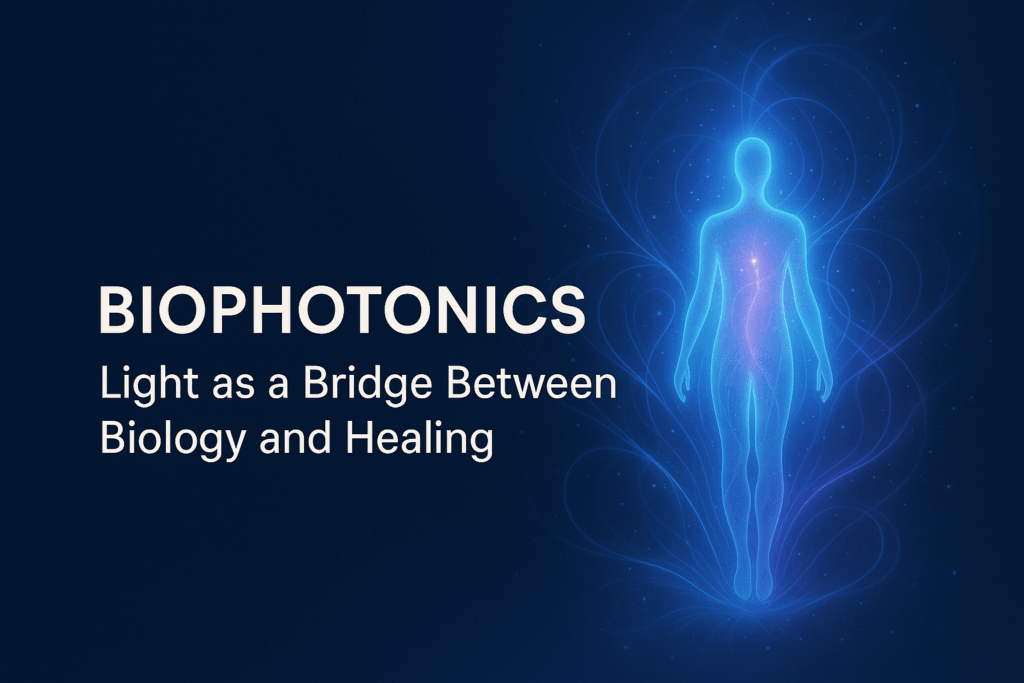
What Is Biophotonics?
Biophotonics is an interdisciplinary field that studies the interaction between light and biological systems. The term combines “bio,” referring to life or living systems, and “photonics,” the science of light. In essence, biophotonics uses light-based technologies to observe, diagnose, and influence biological processes at the cellular and molecular level.
Biophotonic technologies span a wide range of applications—from advanced medical imaging to innovative healing therapies. The core idea is that light, especially in specific frequencies and intensities, can provide valuable information about our biology and even promote health and regeneration.
The Science Behind Biophotonics
Living cells naturally emit very faint light known as biophotons—ultra-weak photons that are generated during normal metabolic processes. This phenomenon was first observed in the 1920s and has since been studied in depth by researchers like Fritz-Albert Popp. These light emissions are not just metabolic byproducts—they’re believed to be part of a communication system within and between cells, acting like a biological “Wi-Fi.”
Biophotonic technologies often work by detecting, analyzing, or enhancing this light. Tools like laser scanning microscopes, spectrometers, and fiber optics are used to image tissues, track cellular functions, or deliver targeted light to influence biological responses.
Benefits of Biophotonics
1. Non-Invasive Diagnostics
Biophotonics enables real-time, high-resolution imaging of tissues without needing invasive procedures. Techniques like optical coherence tomography (OCT) and fluorescence imaging are already widely used in eye care, dermatology, and oncology.
2. Enhanced Healing and Regeneration
Low-level light therapy (LLLT) and photobiomodulation are biophotonic techniques that use red or near-infrared light to stimulate healing in soft tissues, reduce inflammation, and improve circulation. These are used in everything from sports injury recovery to chronic wound treatment.
3. Cellular Communication and Energy Balance
Some scientists and holistic practitioners believe that biophotons play a role in maintaining biofield coherence—the energetic harmony of living systems. Therapies that use specific light frequencies (sometimes based on sacred geometry or solfeggio tones) aim to support this coherence, potentially improving mood, clarity, and vitality.
4. Cancer and Disease Detection
Biophotonics is increasingly used in cancer research and early detection. Fluorescent markers and optical imaging can highlight cancer cells before they’re visible by conventional means, allowing for earlier intervention and more precise treatment.
5. Personalized Medicine
As biophotonics becomes more refined, it offers the potential to measure the energetic and cellular states of an individual and tailor therapies accordingly—bridging modern diagnostics with integrative, patient-specific treatments.
Applications in Wellness and Integrative Medicine
In wellness centers and holistic healing environments, biophotonic principles are often integrated with energy healing modalities, such as:
- The Light System and Energy Enhancement Systems (EES), which emit scalar fields and light frequencies to promote cellular optimization.
- Bio-Well devices, which analyze biophotonic emissions from fingertips to assess stress and energetic balance.
- Red light and infrared therapy, increasingly popular in spas and home healing practices for pain relief and anti-aging.
Future of Biophotonics
As the line between technology and consciousness blurs, biophotonics may become a key pillar in the evolution of medicine. With its ability to interface with the subtle language of light in living systems, it offers a bridge between measurable science and intuitive healing.
The future promises not only improved diagnostics and therapies but a deeper understanding of how light sustains and informs life.
In Summary
Biophotonics reveals that we are, quite literally, beings of light. Through its powerful, non-invasive, and holistic potential, this field helps us harness the intelligence of light to support health, vitality, and inner coherence.
As research expands and technologies become more accessible, biophotonics may help humanity remember a timeless truth: healing often begins with light.
